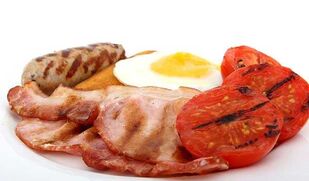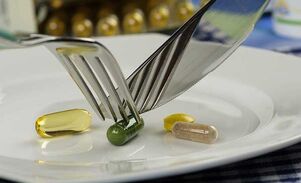
A ketogenic diet, or ketone, or keto is one of the well-studied nutritional systems that has proven beneficial in many experiments and clinical studies.
However, the scheme is complicated. Not suitable for everyone and has many pitfalls.
What is a keto diet
This is a low carb diet with a high fat menu. Same with regular carbohydrate-free diets or the Atkins diet.
A diet in which the amount of carbohydrates is significantly reduced and fat intake increases, translating the body into ketosis.
Ketosis is a metabolic condition in which fat is the body's main source of energy. This occurs when carbohydrate intake, usually the main source of energy, is minimized.
Ketosis occurs during fasting, pregnancy and infancy. It can be artificially created in adults by switching to a high-fat and low-carb diet.
In ketosis, insulin levels decrease. Large amounts of fatty acids leave adipose tissue and enter the liver, where it is oxidized and converted into ketone bodies, or ketones, which are a source of energy.
Formed:
- beta-hydroxybutyrate, a major ketone body circulating in the blood;
- acetoacetate - the main product of the liver;
- acetone is a volatile ketone responsible for the formation of certain odors.
The ketone body can penetrate the blood-brain barrier and feed the brain cells in the absence of glucose.
The constant decrease in insulin and sugar levels that occur with a ketogenic diet has many beneficial effects on human health.
How ketosis differs from ketoacidosis
Ketosis that develops with a carbohydrate-free diet is essentially different from diabetic ketoacidosis.
People who do not have diabetes have normal blood sugar levels. When carbohydrate storage is depleted, the liver begins to produce glucose from other sources (pyruvate, glycerol, and amino acids).
This makes it possible to maintain normal blood glucose levels and ensure ketone body concentrations within the range of 8 Mmole / L, which is safe for health.
In type 1 diabetes patients, ketone levels reach 20 Mmol / L. And this condition is life threatening.

What keto foods look like: options
- Standard protocol. This means consuming a lot of protein and fat and reducing carbohydrates - no more than 50 g a day. This menu includes 75% fat, 20% protein and 5% carbohydrates.
- A high protein keto diet. Just like a standard regimen, just more protein. 60% fat, 35% protein, 5% carbohydrates.
- Cyclic options. With this diet, 5 days followed by a standard diet and 2 days high carbohydrates. Reminds of BUCH diet.
- Targeted approach. They eat according to the ketogenic scheme, and consume carbohydrates before and after exercise.
All scientific studies conducted only evaluate the standard version.
Cycle and target approaches are used only by athletes, most bodybuilders. This eating pattern is not intended to help lose weight or improve health.
How the keto diet affects weight loss
Scientific evidence shows that this is a very effective weight loss method that provides more consistent results than traditional and low-fat weight loss systems that require strict calorie restriction.
It has been shown that those who lose weight on a ketogenic diet lose weight 2. 2 times more, volunteers on a low-fat diet with strict calorie restriction.
The mechanism of weight loss on the keto diet is as follows.
- Intake of essential protein, which is necessary for healthy weight loss.
- Gluconeogenesis. Protein and fat are converted into carbohydrates. This process can burn extra calories throughout the day.
- Suppress appetite. A ketogenic diet normalizes the levels of the hormones leptin and ghrelin, which are responsible for eating behaviors.
- Increases insulin sensitivity. Insulin resistance leads to weight gain. Thus, increased sensitivity to hormones accelerates metabolism and induces rapid breakdown of fat deposits and decreased rates of new formation.
Treatment and prevention of metabolic syndrome and type 2 diabetes

Metabolic syndrome is a metabolic disorder that significantly increases the risk of obesity, type 2 diabetes, and heart disease.
The signs that indicate a person has metabolic syndrome are:
- suspended blood pressure;
- abdominal obesity (large stomach);
- high blood sugar (although diabetes has not been diagnosed);
- Indicators of weak lipid profile (rules for self-decoding analysis for cholesterol).
All of these indications can be improved without medication by changing lifestyle and diet, for example, by switching to a ketone diet.
- Increasing the body's sensitivity to the hormone insulin plays an important role in the treatment and prevention of diabetes and metabolic syndrome. With the keto diet, insulin sensitivity increased by 75%. Some people with diabetes may even stop taking their medication.
- Improved lipid profile indicator. Positive changes affect cholesterol and triglyceride levels.
- Additional support for the body is provided by the ketone-forming body, which in turn has its own beneficial nutrients.
What other therapeutic effects are there on the keto diet?
- Help in the treatment of epilepsy. Recent meta-analyzes from 70 clinical studies have found that the keto diet reduces the amount of seizures by 50% in 46-62% of cases. The exact mechanism of action of dietary anticonvulsants has not been determined. Scientists believe that a positive effect can be attributed to an increase in the amount of glutathione antioxidants in the mitochondria, an increase in the neurotransmitter effect of GABA and adenosine inhibitors, etc.
- Alzheimer's disease therapy. Several small studies have shown that ketone nutrition improves the condition of patients with mild Alzheimer’s disease. In patients with this disease, the supply of glucose to the brain is disrupted. And the keto body makes it possible to feed the brain with energy without the participation of glucose, thus reducing the toxic effects of glutamate.
- Support for patients with parkinsonism. According to some studies, a carbohydrate-free diet is beneficial for Parkinson's disease sufferers by preventing the death of dopaminergic neurons and mitochondrial damage.
- Helping children with autism. There is speculation that the keto diet improves behavior in children with autism. And it is more effective than the Atkins diet, gluten-free and casein-free foods. However, the data on this problem is so small that it cannot be considered completely reliable.
- Cancer treatment. Tumor cells function exclusively on glucose. They cannot get energy from the ketone body. Thus, the transition to ketogenic nutrition induces cell death in malignant neoplasms. However, experts emphasize that the method can only be used in conjunction with chemotherapy treatment and with a doctor's permission. And do not expect too much in this approach.
- Improves skin condition. In particular, get rid of acne. Low insulin levels and the elimination of all industrial-produced foods from the diet, as required by the diet, eliminate chronic inflammation affecting the skin.
- Treatment of polycystic ovary syndrome. The disease is associated with impaired glucose and androgen metabolism. The ketogenic diet helps restore the insulin sensitivity that afflicts women with polycystic syndrome.
Doses and Prohibitions of the Keto Diet: Food List

- Sugar in any form. Obviously sweet products (sweets, ice cream) and products that do not look sweet, but contain these ingredients in their composition, are also classified as prohibited. It can even be a store-bought tomato sauce.
- Cereals: wheat (including spelled), rye, barley, rice, corn.
- Vegetable oils that make you fat - soybeans, corn, sunflower, rapeseed. And also trans fat.
- Fruit. Except for a handful of berries like strawberries.
- Beans. Beans, peas, lentils, etc. Can be used in green, for example nuts.
- Tubers and rhizomes. Potatoes, carrots, beets, parsnips, etc.
- Any "diet" food, such as low-fat cottage cheese (in such products, fat is replaced by sugar).
- Products with sweeteners in the form of sugar alcohol (xylitol, eritritol) - have a negative effect on the ketone body.
- Dips and sauces, in the preparation of sugar, starch, flour are used.
- Alcohol.
- All finished products are produced by the food industry.
Ketogenic diet: what you can and should eat
- All kinds of meat: beef, pork, chicken, lamb, etc.
- Fish and seafood.
- Eggs.
- Vegetables. Prefer green. Others are also allowed (tomatoes, eggplant, onions, peppers) - the main thing is that there is a lot of fiber, and almost no carbohydrates can be digested.
- Fatty dairy products - cream, butter, cheese.
- Nuts and seeds.
- Mushrooms.
- Proper vegetable oils: olive, coconut oil, avocado.
- Fermented foods: natural yogurt, kefir, sauerkraut, etc.
- Spices and herbs.
Sample weekly menu for women and men on a ketogenic diet
| Monday | Tuesday |
Breakfast: scrambled eggs with bacon and tomatoes. Lunch: cauliflower soup and broccoli in chicken broth, boiled chicken with eggplant and sauteed striped pepper. Dinner: a piece of red fish baked in sour cream with a vegetable salad. |
Breakfast: natural fatty yogurt without sweeteners or flavors with nuts and / or seeds. Lunch: bone broth (preferably beef) with hard eggs, a slice of boiled beef with sauerkraut (without potatoes). Dinner: chicken stew with zucchini. |
| Wednesday | Thursday |
Breakfast: scrambled eggs with bell peppers. Lunch: fish soup (without potatoes), pork chops with green bean stew. Dinner: grilled chicken breast with sour cream, cucumber and tomato. |
Breakfast: regular cottage cheese without sugar and flavor. Lunch: mushroom soup (without potatoes and noodles), minced meat steak with egg and vegetable salad. Dinner: grilled fish under cheese crust with vegetables. |
| Friday | Saturday |
Breakfast: soft boiled eggs with slices of cheese. Lunch: sour cabbage soup (without potatoes), boiled chicken liver with sour cream and fried onions, with shirataki noodles. Dinner: salad with fish and / or seafood (without potatoes and rice), but with green vegetables, tomatoes, etc. |
Breakfast: cottage cheese with ingredients. Lunch: bone broth with meatballs (without flour or bread), beef azu with boiled cabbage (fresh or sour). Dinner: boiled chicken with carrots and cucumber salad. |
| Sunday | Switch to next week |
Breakfast: scrambled eggs with feta cheese. Lunch: Light vegetable soup with cauliflower and broccoli (without potatoes), grilled chicken all over the oven, with cucumber and tomato salad. Dinner: mushrooms, boiled with sour cream, with vegetable salad. |
Repeat the first week, trying to add maximum variation to the menu. There are many recipes in the world to suit the keto diet. |
Rules to be followed
- You can and should eat your fill regardless of calories.
- Only the right fats can be eaten. This means cooking is only allowed with oil that can withstand heat. Salads must be lubricated only with proper diet.
- There should be a lot of fat in the diet. You cannot focus on protein.
- Tea, coffee, instant chicory and many other beverages are allowed. The main selection criteria is the absence of sugar and sweeteners in beverages.
- You should try to include a lot of spices in your food.
Healthy snacks while losing weight on a ketogenic diet
Since ketogenic diets do not require calorie counting, snacks are not only allowed, they are even encouraged. But they must be right.
Allowed:
- boiled eggs;
- meat chips;
- cheese;
- nuts, seeds, as well as a variety of pasta and oils prepared from them;
- berries, for example, strawberries with cream (however, you should not be carried away by berries);
- natural yogurt and other natural fermented milk products;
- all vegetables allowed by diet and light salads from them.
All dairy products, whether cheese or yogurt, must have a normal fat content.
What is "keto flu": symptoms
The first few days switching to a low-carb diet can be difficult. Unpleasant symptoms are often noted, called "keto flu".
Can be marked:
- Constant hunger, especially sugar cravings;
- fatigue;
- insomnia;
- discomfort in the abdominal area, abdominal pain;
- nausea and vomiting; constipation or diarrhea;
- problems concentrating;
- headache and dizziness;
- muscle aches and cramps;
- irritable, crying.
How long does ketoflu last
From a few days to a few weeks. This is associated with the restructuring of the body to use fat as the main source of fuel. Although adaptation occurs, energy may be insufficient, leading to the listed symptoms, which are unpleasant. But they pose no danger.
Ketone bodies are always present in the blood in small amounts. After the first 2-3 days of a strict carbohydrate-free diet, the liver begins to produce ketones and its blood levels rise to 2-3 mM.
Adjustment is completed when the cell, placed in a state of carbohydrate starvation, reduces the body's absorption of ketones from the blood, increasing its concentration to 8 mM. At this point, the effective transport of ketones across the blood-brain barrier begins.
Why some people easily adapt to a ketogenic diet, while others find it difficult, has yet to be precisely determined. It is assumed that one's food addiction is important. The more easily digested carbohydrates he eats, the harder the transition. Genetic predisposition is very important.
How to incorporate ketosis quickly into the keto diet

- Proper water regime. When carbohydrates are removed from food, glycogen storage decreases in the body. As glycogen collects water around it, with a decrease in its volume, dehydration can develop, leading to fatigue and muscle aches.
- Only light physical activity. During the body adjustment period, only light exercise is allowed: walking, yoga, slow cycling. All types of exhausting fitness must be avoided.
- Recommended mineral supplement intake:
- sodium - 3-4 grams per day;
- potassium - 1g;
- magnesium - 0. 3g.
Supplements with creatinine monohydrates and caffeine are also indicated.
Keto breathing and the smell of certain urine
The transition to a diet rich in carbohydrates with a lot of fat is often accompanied by the occurrence of certain odors from the mouth. The person himself often feels it as a metallic taste in the mouth. People around you usually think of it as a nail polish remover. Some people think it smells like fruit. The same odor is obtained with urine.
The phenomenon is due to the formation of volatile acetone ketones, which are often found in nail polish removers.
Odor is not a side effect. This only shows that the body shifts to working on fat and forms ketone bodies. It does not endanger health. But that is not pleasant for the person himself and for the people around him, especially when breathing.
To reduce the severity of symptoms, you need to:
- drink more fluids;
- eat less protein;
- use mint gum;
- slightly increases the amount of carbohydrates (only if you eat less than 50 g a day).
After 1-2 weeks, the odor will go away on its own.
Side effects of keto diet delay
In addition to ketoflu, which disappears within a few weeks, this diet regimen can cause delayed side effects. Possibility:
- problems with the digestive system caused by excessive fat intake and dysfunction of the intestinal microflora;
- gradual increase in cholesterol levels;
- increased load on the kidneys, which can increase the likelihood of kidney failure and cause urolithiasis;
- decrease in bone density.
Potential nutritional deficiencies in long-term ketogenic diets

Since the diet cannot be described as balanced, the long-term diet can lead to a lack of some important components.
- Calcium. Leaves in urine. Due to the excess fat, urine becomes too acidic, and the body has to alkalize with calcium. In addition, lack of carbohydrates interferes with the absorption of these trace elements.
- Magnesium. According to assumptions, the gradual development of deficiency is associated with the withdrawal from foods rich in these micro-elements - cereals and fruits.
- Iron. Excess fat in food interferes with iron absorption.
- Sodium and Potassium. Due to the decrease in insulin levels, loss through the kidneys increases. However, unlike other micronutrients, such as calcium or magnesium, deficiency is found over time, potassium and sodium disappear quickly. And in many ways, its deficiency is due to the symptoms of the keto flu, which gradually passes.
- Selenium. Deficiencies may be due to the lack of these minerals in fat-rich foods. The exception is Brazil nuts, one portion giving the body 100% of its daily selenium value.
- Karnitin. The downside is that the compound is consumed too quickly on a fat diet.
If you have been on a keto diet for a long time, you should regularly check the levels of all the ingredients that may be deficient over time. It is recommended to take supplements with risky nutrients.
Who should not switch to keto food: contraindications
- Children, pregnant and lactating women, patients with diabetes mellitus and cancer are allowed to switch to a ketogenic diet only if prescribed by the attending physician and under their supervision.
- Diet is contraindicated in people with the genotype of ApoE3 and ApoE4, as it can cause life-threatening cholesterol levels.
- Do not follow epilepsy patients with KCNJ11 and BAD genes.
- Serious liver and / or kidney disease are contraindicated in following this diet regimen.
Conclusion
The keto diet is a fairly complex eating system that requires almost complete carbohydrate rejection and the introduction of large amounts of fat into food.
Switching to a ketogenic diet is often difficult to tolerate.
Dietary regimens have received a lot of scientific research, many of which prove its benefits for weight loss, treatment of type 2 diabetes and neurodegenerative diseases, normalization of lipid profile, and elimination of metabolic syndrome.
However, not many studies have evaluated the health effects of a prolonged diet (more than a year) on health. And, according to some assumptions, the constant presence of such a diet can be detrimental to health.































